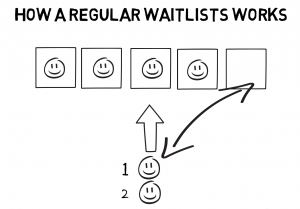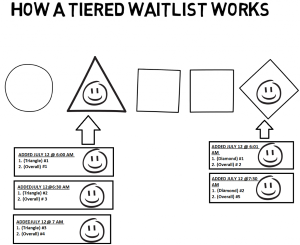The Human Biology Program utilizes a special type of waitlist for our courses. We do this to allow set types of students who need priority in a course to be able to enrol into spots first, but also to allow students who want the course(s) to enrol on waitlists from the very first day of course enrolment, instead of having to attempt to enrol on different days throughout the course enrolment cycle. The special type of waitlist is called a "tiered waitlist."
To explain how a tiered waitlist works, we must first explain how a regular waitlist works.
Let's say there is a course, UT100H1. This course has five spots that are open to all types of students, meaning any student in any program in any year can enrol.
Once the five spots are filled, a waitlist forms, in first-come-first-served order, otherwise known as timestamp order; the earlier a student adds themselves to a waitlist, the higher on the waitlist they are.
Once a spot opens, the first student on the waitlist gets that open spot.

Sometimes though, a class needs to reserve a different number of spots for multiple types of students. This can be because it is a course needed for a program with a major and a specialist option, and/or it is a 300-level course so priority is given to 3rd year students, but 4th year students need to eventually be allowed to enrol. What a unit will do is designate spots for each type of student that will need to enrol in the course.
What happens is that once the spot(s) reserved for the category a student meets (i.e. 4th year neuroscience major) is full, all other students in that same category have to come back at a later date and enrol even if the class still has spaces open.

A regular waitlist will not start until all spaces become equal (usually after all years of Faculty of Arts & Science students have had the opportunity to enrol in courses).
A tiered waitlist works differently in that it allows students to add themselves to a waitlist immediately once spots reserved for their category are full.
What happens is that the waitlist is assessed differently at different periods of time: initially it is ‘tiered’ and they are evaluated by their timestamp in relation to their category; later this changes so that they are evaluated based solely on their overall timestamp order.

This means, that as spaces become available in a category, students on a waitlist can fill those spots immediately, without having to check ACORN every day to see if there is an open spot. It also means, that when all spaces become equal, the category waitlists seamlessly merge into one waitlist based on overall timestamp order, just like a regular waitlist.
Thus, if there are still empty spaces in a course when all spaces become equal, those spaces are immediately filled by the students on the now merged waitlist.
Why does HMB use this type of waitlist? Well, for several reasons:
- It guarantees 4th year students priority in all courses they are eligible to take, even if priority enrolment must first be given to 2nd or 3rd year students, provided that 4th year students add themselves to the waitlist before the 3rd year students, which is now possible as a student can add themselves to a waitlist earlier on in course enrollment, and 4th year students have earlier start times than 3rd year students.
- It allows the HMB office to see where there may be high enrolment pressure areas, where a number of 4th year students need a 300-level course for program completion, and allows them more time to plan and act accordingly to help these 4th year students.
- It allows 2nd and 3rd year students to take courses in the advised order, without having to compete against higher year students for spots.
- It reduces the number of unique days a student has to log on to ACORN and attempt to enrol in a course as the waitlists exist in all courses starting from the first day of enrolment.
Please note that students will only be able to see their category waitlist rank on ACORN until the waitlists merge.
Questions? contact hmb.undergrad@utoronto.ca


